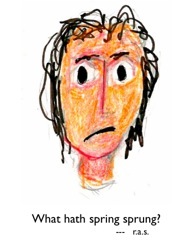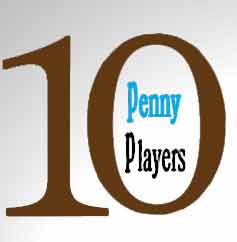Ten Penny Players' Heuristic Approach
to Poetry
The 7 Heuristic Elements of Poetry are conceptual tools which
may aid teachers designing poetry curriculum or infusing
poetry into their curriculum.
Music
and mimesis lead to a catharsis (purging of fear and pity as Aristotle
described in Poetics). The critical eye then turns to what
raises the emotions to the sublime, an
alchemical and psychological process. As tastes vary, each work of art
is seen as a unique transcendence. The poems are connected
through symbolism and symbolic use of language. By the
end of the 20th century the technologies needed to publish were
available to a greater part of the population than ever before.
Using poetics as
a central motive to learning, students are encouraged to explore
communication. Classrooms become host to a growing human discourse
that affirms cultures and individuals. Educators approach each student as a potential author,
capable of poetic expression.
The inclusive classroom needs to address the substantial disparity
of student aptitudes, while articulating all its students' cognitive
growth. A poetics curriculum would enable the consideration of
a vast body of literature from a variety of standpoints -- yet
upon enough common ground for informed discussion to ensue. It
is a curriculum that can respond to a multicultural literature
and accommodate diversity.
Curriculum Objectives
music 
|
Recognize sound patterns:
repetition, syllable, accent, meter, rhyme,
alliteration, asonance, and
dialect.
Connect the body's heartbeat and breathing
with sound patterns reflected in lines of poetry. |
mimesis 
|
Observe and quote accurately.
Imitate a familiar voice.
Write in dialect.
|
catharsis 
|
Read aloud lines of poetry that
convey terror and pity.
Explore emotional connotations of words and sound patterns.
Write a description that conveys a strong emotion.
|
sublimation 
|
Discuss questions of taste and personal appreciation.
Discuss what is meant by the beautiful or the sublime.
Rewrite lines of original poetry to achieve a sense of beauty.
|
transcendence 
|
Recognize unique aspects of individual works.
Seek levels of meaning beyond egocentrism.
Acknowledge other perspectives.
|
|
symbolism 
|
Discuss allegories,
metaphors, symbols, similes, and tropes.
Explore dreams as
representations of one phenomenon by another.
Explore vocabulary, grammatical conventions, punctuation and
spelling.
Realize it is not the symbols alone, but the relationship (pattern)
among the symbols that determine meaning.
Discuss words and letters as symbols.
|
publication 
|
Discuss post publication responsibilities and responses.
What are the implications of making one's work public?
Student write, edit, design and print literary magazines and chapbooks.
Students use desktop publishing software
to prepare publications.
Students publish in print and on the Internet.
|
In the New Republic of 1916 Randolphe Bourne wrote, "Art
education in art appreciation will be valueless if it does not
devote itself to clarifying and integrating natural taste. The
emphasis must be always on what you do like, not on what you ought
to like."
For a lecture given at Columbia University in 1947, Delmore
Schwartz wrote, "The point is that the more we know about
the history of literary reputation and literary opinion, the more
conscious we are of how unjust and how stupid even the greatest
critics can be, the more likely we are to avoid such errors in
our own experience of literature."

